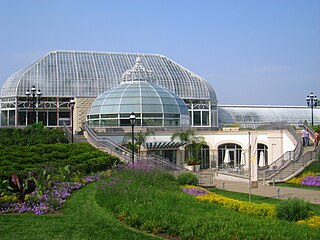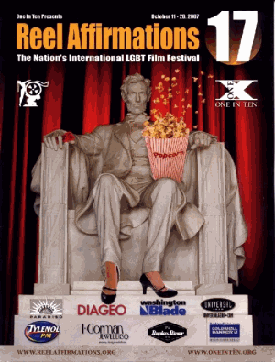
Pittsburgh is a city in the Commonwealth of Pennsylvania and the county seat of Allegheny County. It is the most populous city in both Allegheny County and Western Pennsylvania, the second-most populous city in Pennsylvania after Philadelphia, and the 68th-most populous city in the U.S. with a population of 302,971 as of the 2020 census. It is the largest city of the Greater Pittsburgh metropolitan area of Western Pennsylvania; its population of 2.457 million is the largest in both the Ohio Valley and Appalachia, the second-largest in Pennsylvania, and the 26th-largest in the U.S. It is the principal city of the greater Pittsburgh–Weirton–Steubenvillle combined statistical area that extends into Ohio and West Virginia.

The Academy of Motion Picture Arts and Sciences is a professional honorary organization in the United States of America with the stated goal of advancing the arts and sciences of motion pictures. The Academy's corporate management and general policies are overseen by a board of governors, which includes representatives from each of the craft branches.

The Carnegie Prize is an international art prize awarded by the Carnegie Museum of Art in Pittsburgh, Pennsylvania. It currently consists of a $10,000 cash prize accompanied by a gold medal.

The Wexner Center for the Arts is the Ohio State University's "multidisciplinary, international laboratory for the exploration and advancement of contemporary art."

The Carnegie Museum of Art is an art museum in the Oakland neighborhood of Pittsburgh, Pennsylvania. The museum was originally known as the Department of Fine Arts, Carnegie Institute and was formerly located at what is now the Main Branch of the Carnegie Library of Pittsburgh. The museum's first gallery was opened for public use on November 5, 1895. Over the years, the gallery vastly increased in size, with a new building on Forbes Avenue built in 1907. In 1963, the name was officially changed to Museum of Art, Carnegie Institute. The size of the gallery has tripled over time, and it was officially renamed in 1986 to "Carnegie Museum of Art" to indicate it clearly as one of the four Carnegie Museums.

Carnegie Museums of Pittsburgh are four museums that are operated by the Carnegie Institute headquartered in the Carnegie Institute complex in the Oakland neighborhood of Pittsburgh, Pennsylvania, United States. The Carnegie Institute complex, which includes the original museum, recital hall, and library, was added to the National Register of Historic Places on March 30, 1979.

New York Film Academy – School of Film and Acting (NYFA) is a private for-profit film school and acting school based in New York City, Los Angeles, and Miami. The New York Film Academy was founded in 1992 by Jerry Sherlock, a former film, television and theater producer. It was originally located at the Tribeca Film Center. In 1994, NYFA moved to 100 East 17th Street, the former Tammany Hall building in the Union Square. After 23 years of occupancy, the academy relocated from Tammany Hall to 17 Battery Place.
The Culture of Pittsburgh stems from the city's long history as a center for cultural philanthropy, as well as its rich ethnic traditions. In the 19th and 20th centuries, wealthy businessmen such as Andrew Carnegie, Henry J. Heinz, Henry Clay Frick, and nonprofit organizations such as the Carnegie Foundation donated millions of dollars to create educational and cultural institutions.

The American Alliance of Museums (AAM), formerly the American Association of Museums, is a non-profit association whose goal is to bring museums together. Founded in 1906, the organization advocates for museums and provides "museum professionals with the resources, knowledge, inspiration, and connections they need to move the field forward."

The Pittsburgh Center for the Arts (PCA) is a non-profit community arts campus that offers arts education programs and contemporary art exhibitions in Pittsburgh, Pennsylvania, United States.

Reel Affirmations (RA) is a non-profit, all-volunteer LGBT film festival in Washington, D.C. Founded in 1991 and held every year in mid-October, as of 2011 Reel Affirmations was one of the largest LGBT film festivals in the United States. Baltimore's Gay Life newspaper called it "one of the top three films festivals for the entire LGBT community." A 2007 guidebook claims it was one of the largest LGBT film festivals in the world. A listing of LGBT film festivals claims it is the largest all-volunteer film festival in the world.
Thaddeus G. Mosley is an American sculptor who works mostly in wood and is based in Pittsburgh, Pennsylvania.
Peggy Ahwesh is an American experimental filmmaker and video artist. She received her B.F.A. at Antioch College. A bricoleur who has created both narrative works and documentaries, some projects are scripted and others incorporate improvised performance. She makes use of sync sound, found footage, digital animation, and Pixelvision video. Her work is primarily an investigation of cultural identity and the role of the subject in various genres. Her interests include genre; women, sexuality and feminism; reenactment; and artists' books. Her works have been shown worldwide, including in San Francisco, New York, Barcelona, London, Toronto, Rotterdam, and Créteil, France. Starting in 1990, she has taught at Bard College as a Professor of Film and Electronic Arts. Her teaching interests include: experimental media, history of the non-fiction film, and women in film.
The Silk Screen Asian American Film Festival was a 10-day film festival held annually in Pittsburgh, Pennsylvania to show the most recent films and music by artists with Asian ethnic origins, such as from Japan, China, Taiwan, India, Pakistan, Indonesia, Korea, Turkey, the Philippines, and The Middle East. It also included films whose topical matter is about Asians or Asian Americans.
Pittsburgh Filmmakers' School of Film, Photography, and Digital Media was a private institution of higher education located in Pittsburgh, Pennsylvania. It was an accredited film school that was run by Pittsburgh Filmmakers, a well-known regional media arts center and non-profit organization.

The Three Rivers Film Festival is an annual film festival, held in Pittsburgh, Pennsylvania and is presented by Film Pittsburgh.

Kaz Rahman is a Canadian visual artist and filmmaker. His work explores and coalesces the intersection between Islamic artistic expression, the natural elements and contemporary culture.

Michael Lotenero is an American artist, graphic designer, illustrator, and musician who emerged from the Pittsburgh art scene. He is known for his figurative abstracts, sculptures, and iconic heads.
Sally Foy Dixon was an American arts administrator, curator, and advocate of American experimental film and filmmakers. She was a Film Curator at Carnegie Museum of Art in Pittsburgh, Pennsylvania from 1970 to 1975 and interim director of Film in the Cities in Minneapolis, Minnesota, from 1978 to 1979. She also served as Director of the Bush Foundation for Artist Fellowships from 1980 to 1996 and was a consultant for the Pew Charitable Trusts, The MacArthur Foundation, the Herb Foundation, and the Leeway Foundation.
Alisha B. Wormsley is an interdisciplinary artist and cultural producer. Her work is about collective memory and the synchronicity of time, specifically through the stories of women of color. She states her work is "the future, and the past, and the present, simultaneously."















